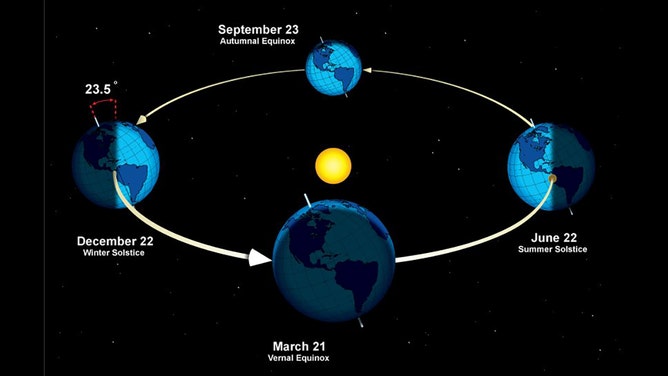Why do sunrise and sunset times change during the year?
The country’s 50 states are spread among six time zones. Eastern Maine has some of the earliest sunrise times, while Alaska and Hawaii have the latest sunsets.
Sunrise snapshot from Fairbanks, Alaska
Today's sunrise snapshot is from Fairbanks, Alaska.
Sunrise and sunset times constantly fluctuate during the year due in part to Earth’s tilt and the changing of the clocks for daylight saving time.
Sunrise officially begins when our giant star starts to appear above the horizon, marking the end of twilight.
Times of sunrise and sunset vary by location, with fewer fluctuations as you head closer to the equator and greater changes as you reach the poles.
In the U.S., Hawaii’s sunrise and sunset times fluctuate the least, while communities in Alaska can go without seeing either.
Everyone else in the mid-latitudes does not experience the extremes seen in Alaska or the lack thereof in Hawaii.
For instance, in Cincinnati, its earliest sunrise time happens around the summer solstice at 6:11 a.m., and its latest sunrise time happens during the winter at 7:57 a.m. – a difference of 1 hour and 46 minutes.
The city’s sunset times vary more significantly, with the earliest happening in the winter at 5:15 p.m. and the latest during the summer at 9:08 p.m.- a variance of nearly 4 hours.
THIS ALASKAN TOWN JUST SAW ITS LAST SUNSET UNTIL AUGUST AS SUMMER SOLSTICE NEARS
What causes these varying times?
Earth’s tilt remains relatively constant, but an important element in increasing and decreasing daylight is the elliptical orbit of Earth around the Sun.
Around the summer solstice, the Northern Hemisphere is positioned pointing towards the Sun, which causes longer days.
The opposite is true during the winter solstice when the Northern Hemisphere finds itself tilted away from the Sun.
The opposite effect happens in the Southern Hemisphere when the summer solstice is observed during December, and the winter solstice takes place in June.

The Earth's orbit around the Sun gives our planet its four seasons.
(National Weather Service / NOAA)
Further complicating matters is the adjustment of clocks from standard time to daylight saving time and vice versa.
Ever since 1966, most of the country has officially lost an hour during the spring and gained an hour in the fall.
The change means that if a city has a sunrise time of about 6:30 a.m., its residents will see the Sun at 7:30 a.m. on the first day of daylight saving. If sunset occurred at 6:30 p.m. before the annual clock change, it would happen at 7:30 p.m. once daylight saving time began.
The U.S. is not the only country that observes the changing of the clocks. Dozens of other nations and territories, including Canada and most of Europe, participate in the tradition.
Supporters of time change claim the practice is valuable in the quest to save energy and makes the summer months more enjoyable by allowing nightfall to occur at a later time.
What are the impacts of Daylight Saving Time on my health?
Get ready to lose an hour of sleep. On Sunday morning, most people in the U.S. will turn their clocks ahead by one hour in observance of Daylight Saving Time. But what are the impacts it has on your health? Changing sleep cycles even by just an hour can impact our circadian rhythm. Joining FOX Weather is Dr. Helmut Zarbl, an occupational medicine professor at Rutgers University.

